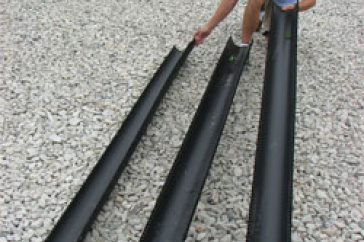New Lot Provides Parking Plus Stormwater Solution and Research

Caption: Robert Roseen demonstrates how the sampling gallery will collect stormwater from three different levels in the parking lot subsurface. Credit: Beth Potie
DURHAM, N.H. - To the University of New Hampshire faculty, staff and visitors who park outside the Elliott Alumni Center, D Lot may seem like just another parking lot, 53,000 square feet of black asphalt, white lines, and never enough empty spaces.
But to Robert Roseen, director of the UNH Stormwater Center, the new porous asphalt D Lot will be a mighty multitasking piece of infrastructure, providing not just parking but also improved water quality and research data.
"It demonstrates the university's commitment to sustainability, stormwater management and long-term planning," says Roseen, who is a research assistant professor of civil engineering. Roseen and the center partnered with University Transportation Services and Facilities Construction and Design to go beyond simply resurfacing the crumbling lot, instead replacing it with a more expensive but longer-lasting and environmentally friendly technology. It will be the largest porous parking lot at UNH.
Porous asphalt lets stormwater drain through the parking lot instead of sitting on the surface. Made of an asphalt mix that uses larger-than-customary aggregate and admixtures Roseen calls the "special sauce" that add strength and durability, the surface has visible holes in it. Pollutants like sediment, heavy metals and petroleum products that are carried by rain and snow are filtered by the 32-inch subsurface of layered rocks and sand. Roseen estimates that this lot, which sits atop drainage-impeding clay, will reduce the volume of runoff by between 25 and 50 percent.
Stormwater Center research has also found that porous surfaces generally last longer than traditional ones and require up to a 75 percent reduction in salt for winter deicing. That's because once the lot is plowed, any additional moisture from melting infiltrates through the surface rather than sitting atop it, where it can freeze again.
Hiding beneath the porous surface of D Lot are several mechanisms that will allow Roseen and his colleagues to collect data on the effectiveness of this particular treatment. Stormwater from a range of subsurface levels will run into a sampling gallery, which the researchers can access to monitor the quality, quantity and temperature of the stormwater filtered through the lot. "This data helps us improve and refine this technology," says Roseen.
Dirk Timmons, director of transportation, says that supporting UNH's research and academic mission was a major factor in his allocation of the extra funding to replace D Lot with a pervious surface. In addition, he says, "University Transportation Services is committed to using the best application for the area whenever possible. The clay soil in this lot is creating poor drainage, and we believe that porous asphalt is the best solution."
"As usual, really good things come from a total team being involved," says Larry Van Dessel, executive director of Facilities Construction and Design. In addition to the UNH departments, Van Dessel credits designer Appledore Engineering of Portsmouth and paving contractor Bell and Flynn of Stratham with making the project successful.
The UNH Stormwater Center, part of the Environmental Research Group and the department of civil engineering at UNH, has pioneered the use of porous surfaces in the Northeast, serving as an advisor on many paving projects throughout the region and conducting workshops for civic leaders, municipal officials, designers, and stormwater managers on the use of this rapidly expanding technology. D Lot joins two other porous parking lots on campus: a small porous asphalt area of West Edge parking lot, which serves as a demonstration site, and a pervious concrete lot by the Williamson and Christensen residences. Later this summer, the center will oversee the installation of pervious pavers, a third type of porous surface, in front of Hood House.
Also this summer, the Stormwater Center is working with the City of Rochester, the Cocheco River Watershed Coalition, and the New Hampshire Department of Environmental Services on an extensive stormwater management retrofit for the School Street School in Rochester. Rain gardens, a porous asphalt basketball court and pervious concrete sidewalks will give the school a facelift and better manage its runoff. Perhaps more compelling, says Roseen, is that the project is involving students at the school in learning about water quality and is training Rochester's public works crew in the intricacies of installing low-impact design (LID) stormwater management techniques, which will reduce further costs.
The University of New Hampshire, founded in 1866, is a world-class public research university with the feel of a New England liberal arts college. A land, sea, and space-grant university, UNH is the state's flagship public institution, enrolling 12,200 undergraduate and 2,200 graduate students.
-30-
Photographs available to download:
/unhtoday/news/cj_nr/2010/jul/bp20alumni_03.jpg
Caption: Robert Roseen, director of the UNH Stormwater Center, checks the sampling gallery which he and his colleagues can access to monitor the quality, quantity and temperature of the stormwater filtered through the new porous asphalt D Lot.
Credit: Beth Potier
/unhtoday/news/cj_nr/2010/jul/bp20alumni_01.jpg
Caption: Robert Roseen demonstrates how the sampling gallery will collect stormwater from three different levels in the parking lot subsurface.
Credit: Beth Potier
/unhtoday/news/cj_nr/2010/jul/bp20alumni_02.jpg
Caption: Robert Roseen, director of the UNH Stormwater Center, at the new porous asphalt parking lot adjacent to the Elliott Alumni Center.
Credit: Beth Potier
Editors and reporters: Construction on this porous asphalt parking lot will continue through early August. To visit the site, contact Beth Potier. Robert Roseen is available for interviews at 603-862-4024 or mailto:Robert.roseen@unh.edu"
Latest News
-
December 4, 2025
-
November 26, 2025
-
November 6, 2025
-
November 5, 2025
-
October 24, 2025














































